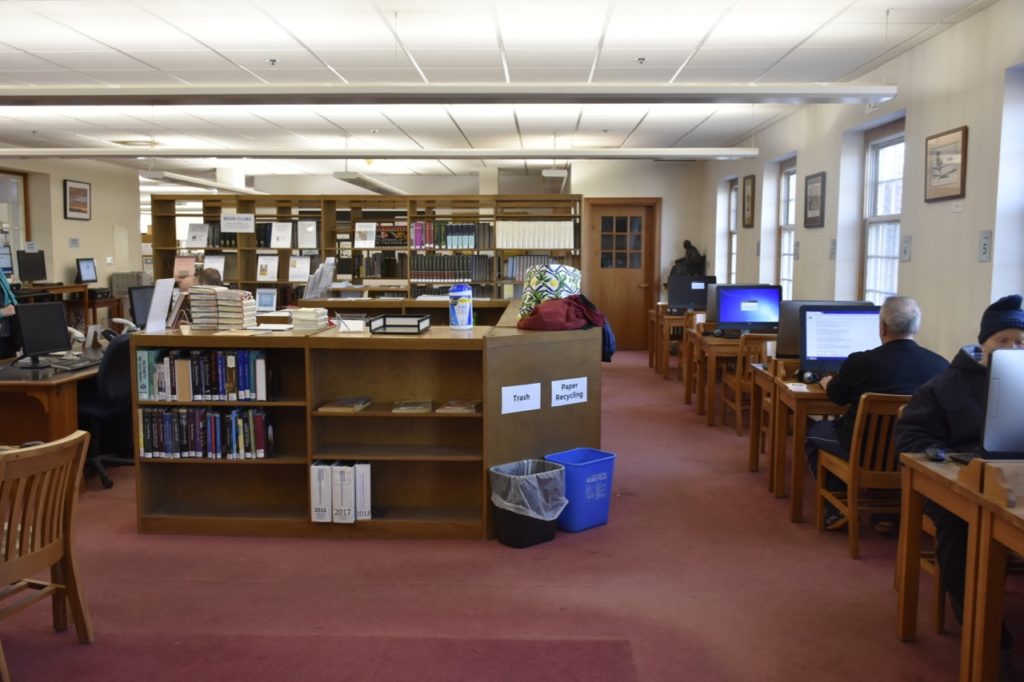Letter: Jones Expansion Plan Has Become Too Expensive

Jones Library computer room. This room is slated to be demolished as part of the proposed Jones Library expansion project. Photo: Art Keene
Amherst resident Roman Handlen, in a guest column in the August 8 edition of the Daily Hampshire Gazette, criticizes those who oppose the continued pursuit of the Jones Library expansion project. I agree with Handlen on one point – we both want to preserve the Jones Library by making it a better space for those who use it. I disagree that the only way to accomplish that is the trustees’ demolition and expansion plan.
It is inaccurate to reduce opposition to a single concern for historical preservation. That is important, but the larger concern is financial. Costs continue to grow, posing substantial risk that Amherst taxpayers could end up paying more than the town share of $15.8 million. Also, the need for expansion is questionable in a town with two other libraries, three university/college libraries, and a shrinking year-round resident population.
Since the town voted to support borrowing approximately $36 million to expand the Library, cost estimates continue to accelerate. It deserves a second look. Many other town needs compete for tax dollars. A new fire station and new DPW facility were given higher priority than the library on the town’s list of capital needs. Our senior center is wholly inadequate, a new school will be built soon, and town properties, including a soon-to-be-vacant Wildwood School, should be rehabilitated to use for programs that have long sought adequate space. We have roads close to impassable, and sidewalks, if they exist, are so deteriorated that walkers prefer the street. Town Council has already increased the borrowing authorization to $46 million, and potential is real that even more will be considered. This is the same Town Council that berated the School Committee on its recent budget and warned of reduced support next year.
Amherst should not support one project at the expense of others. The library plan has become too costly. Instead, a reasonable plan should be adopted, based on repairing deteriorating conditions and fully utilizing existing spaces.
Jones Trustees say expansion is necessary to address deteriorating conditions, deterioration that is the result of years of neglect. Trustees say the library needs more space, yet some existing spaces have been removed from public use and their potential ignored. Trustees say it will cost more to repair than to expand. But those quotes fail to consider potential funding sources, and they include the library’s entire renovation wish list. Library needs must be prioritized, just like they are for every other public building.
Millions already have been spent on designs and related activities, including the costs of a capital campaign that has failed to meet its own goals and is still in arrears of the promise to pay $900,000 to the Town by last January. Two million dollars of Massachusetts historic tax credits have been lost because the design eliminated critical historic elements. Another two million dollars in grants from HUD and National Endowment for the Humanities are at risk. When fundraising fails to close the gap, the town will be expected to meet the shortfall.
One building cannot meet all needs effectively. The long-neglected Civil War Tablets deserve their own space where their full story can be told. ESL and community programs should be held closer to residential areas, eliminating the need to rely on sporadic public transportation and the library’s schedule. Spaces for young people should accommodate boisterous youthful activity without requiring quiet.
I want the Jones Library to be a better resource for those who use it. But even more I want to see all Amherst residents thrive. There are vitally important programs and spaces to develop and support that would make a real difference in peoples’ lives. Let us use our funds wisely, instead of putting so much to support a single building.
Anita Sarro
Anita Sarro is a nurse and retired healthcare attorney and longtime resident of Amherst.

Thanks Anita! The Jones Library demolition expansion project has largely been promoted by marketing sound bites, such as the need for “a dedicated teen space.” I appreciate Anita Sarro’s fresh perspective noting an obvious blind spot: “Spaces for young people should accommodate boisterous youthful activity without requiring quiet.” In this regard, a library would never be the best location for teen space. The town of Amherst owns several other buildings that may be far better suited for a dedicated teen space. For example, what does the Town plan to do with the empty former school building on the South Amherst Common? Or, Wildwood Elementary when it is no longer used for that purpose?